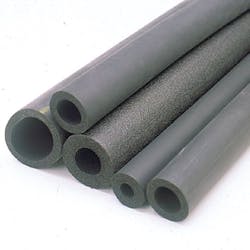Basic Essentials of Insulation for Pipes
We sat down with our partners from Armacell and Frost King – two well-known and respected brands in this space – to help us walk through the essentials of pipe insulation.
1. Why insulate pipes?
There are two main reasons to provide insulation for pipes: to prevent sweating and to prevent freezing. Either situation can lead to costly repairs if left unchecked. When the right amount and type of insulation is applied, you can not only avoid the damaging impact of extreme weather, but the pipes will help your home operate more efficiently throughout the year. This can lead to additional savings through water and energy efficiency.
2. Which material is best for insulating pipes?
Learn the pros and cons of the most common pipe insulation types so you can help educate customers when they’re choosing insulation for pipes in their homes.
- Tubular rubber insulation is offered with and without self-seal adhesive. Arguably, self-seal rubber insulation offers the best value for the price. It is more durable and energy efficient than other pipe insulation materials, and it expands and contracts as temperatures shift. It can also be safely installed over heat cables or heat tape.
- Tubular polyethylene foam comes in easy and economical pre-slit tubes that can be installed quickly onto pipes. This type of pipe insulation is available in self-sealing versions, which seal instantly along the entire length of the longitudinal slits. Polyethylene is more rigid than rubber, as it does not expand and contract as temperatures change. Also, this material should not be applied over heat cables or heat tape.
- Fiberglass pipe wrap kits are also easy and economical. The kits contain a roll of the fiberglass plus a plastic vapor barrier as an overwrap for extra insulation. Multi-purpose fiberglass rolls work as additional insulation in colder areas for extra protection.
- Foil and foam insulation is the simplest, one-step way to insulate pipe. The thin, self-adhesive foam with aluminum foil backing is used by just pressing it into place.
3. What are the keys to proper installation of insulation for pipes?
The most important thing is to ensure that the insulation system is completely sealed – from joints and cuts to intersections and termination points. Use proper insulation adhesive and insulation tape to seal any and all potential entry points for air and moisture. This is where self-seal insulation can save you significant time. Instead of having to apply adhesive along the entire length of your longitudinal cuts, this pre-applied adhesive enables you to apply, seal and then focus on the joints and termination points.
When insulating pipes, avoid shortcuts like duct tape and/or zip ties. Duct tape expands and contracts differently from the insulation, which can cause problems as temperatures shift. Zip ties create compressions points, which can also be problematic.
Also, with certain materials, you need to account for expansion and contraction when making your cuts. With rubber insulation, for example, you want to cut the insulation just slightly longer than the length of pipe. If the pipe is 13 in., cut about a 13 ¼ in. piece of rubber insulation. This will allow the insulation to expand and contract without forcing open seals at the joints and/or termination points.
Maintaining existing insulation is a straightforward task that includes simple inspections as the seasons change. Check pipe insulation by running your finger along the seams and joints – if you can fit a finger between the joint, more adhesive is required. Another important tip for homeowners is to look for signs of squirrels and other pests that can damage or interfere with the pipe insulation. If they see anything, they should call you.
Take the time to check pipe insulation and decide what type is right for each project – preparing the pipes before severe weather hits and checking the work throughout the year will help save money and energy in the long run.

